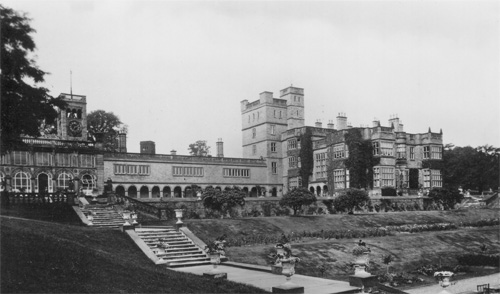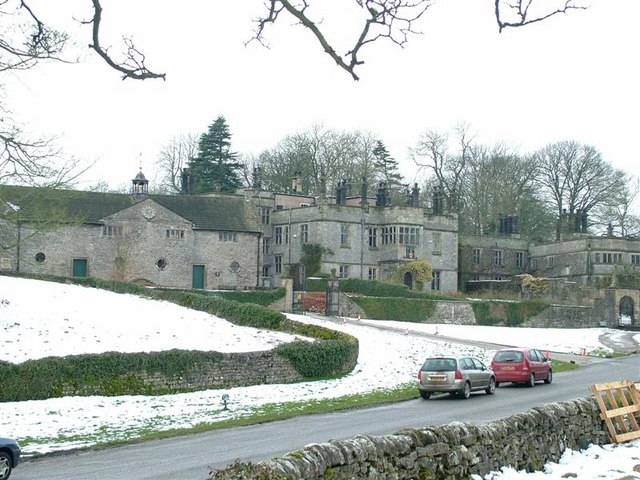|
Osmaston, Derbyshire Dales
Osmaston is a small village and civil parish in the Derbyshire Dales in the county of Derbyshire in England. The population of the civil parish as taken at the 2011 Census was 140. Located two and a half miles south of Ashbourne, Derbyshire, Ashbourne, Osmaston is an archetypal English village with thatched cottages and a village pond. History The village is mentioned in the Domesday Book under the name Osmundestone; the parish was originally named Whitestone. The village church—St Martin's Church, Osmaston, St. Martin's—dates from 1606, although the present building was constructed in 1843. The building was previously a wickerwork construction. Points of interest The war memorial, by the road near the church, commemorates those lost in the First World War. The only pub in the village is the Shoulder of Mutton. There is also a village hall and a primary school. Osmaston Manor was designed by Henry Isaac Stevens for Francis Wright (industrialist), Francis Wright of the ... [...More Info...] [...Related Items...] OR: [Wikipedia] [Google] [Baidu] |
Derbyshire Dales (UK Parliament Constituency)
Derbyshire Dales ( ) is a constituency that has been represented in the House of Commons of the UK Parliament since 2019 by Sarah Dines of the Conservative Party. The constituency was created for the 2010 general election. History Following their review of parliamentary representation in Derbyshire, the Boundary Commission for England created a new constituency of Derbyshire Dales which is almost coterminous with the previous seat of West Derbyshire. Constituency profile The constituency is geographically large and mostly within the Peak District National Park. Its main settlements are Ashbourne, Bakewell Bakewell is a market town and civil parish in the Derbyshire Dales district of Derbyshire, England, known also for its local Bakewell pudding. It lies on the River Wye, about 13 miles (21 km) south-west of Sheffield. In the 2011 census, ... and Matlock. Boundaries The District of Derbyshire Dales, and the Borough of Amber Valley wards of Alport, Crich, and So ... [...More Info...] [...Related Items...] OR: [Wikipedia] [Google] [Baidu] |
Henry Isaac Stevens
Henry Isaac Stevens FRIBA was an architect based in Derby. He was born in London, in 1806, and died in 1873. In the late 1850s he changed his name to Isaac Henry Stevens. Family His parents were Isaac Stevens and Elizabeth Young. He married Anne, the daughter of William Martin on 7 August 1832 in Repton, Derbyshire. They had four children. In the 1861, census he is listed as Isaac H Stevens living in Ashbourne Road, Mackworth, Derbyshire. In the 1871, census he is listed as living at 20 Peartree Road in Litchurch, Derby. Career He was articled to William Martin in Bretby, and was also a pupil of George Maddox. He started in independent practice in 1834 in Hartshorne, Derbyshire. He moved to Derby in the late 1830s or early 1840s and was based at 16 Full Street in Derby. By 1847 he was at 49 Friargate, Derby. In 1857 he is listed as living in Mackworth. He was awarded a Fellowship of the Royal Institute of British Architects on 21 January 1850. He entered into a partnership ... [...More Info...] [...Related Items...] OR: [Wikipedia] [Google] [Baidu] |
Towns And Villages Of The Peak District
A town is a human settlement. Towns are generally larger than villages and smaller than cities, though the criteria to distinguish between them vary considerably in different parts of the world. Origin and use The word "town" shares an origin with the German word , the Dutch word , and the Old Norse . The original Proto-Germanic word, *''tūnan'', is thought to be an early borrowing from Proto-Celtic *''dūnom'' (cf. Old Irish , Welsh ). The original sense of the word in both Germanic and Celtic was that of a fortress or an enclosure. Cognates of ''town'' in many modern Germanic languages designate a fence or a hedge. In English and Dutch, the meaning of the word took on the sense of the space which these fences enclosed, and through which a track must run. In England, a town was a small community that could not afford or was not allowed to build walls or other larger fortifications, and built a palisade or stockade instead. In the Netherlands, this space was a garden, m ... [...More Info...] [...Related Items...] OR: [Wikipedia] [Google] [Baidu] |
Villages In Derbyshire
A village is a clustered human settlement or community, larger than a hamlet but smaller than a town (although the word is often used to describe both hamlets and smaller towns), with a population typically ranging from a few hundred to a few thousand. Though villages are often located in rural areas, the term urban village is also applied to certain urban neighborhoods. Villages are normally permanent, with fixed dwellings; however, transient villages can occur. Further, the dwellings of a village are fairly close to one another, not scattered broadly over the landscape, as a dispersed settlement. In the past, villages were a usual form of community for societies that practice subsistence agriculture, and also for some non-agricultural societies. In Great Britain, a hamlet earned the right to be called a village when it built a church. [...More Info...] [...Related Items...] OR: [Wikipedia] [Google] [Baidu] |
Listed Buildings In Osmaston, Derbyshire Dales
Osmaston, Derbyshire Dales, Osmaston is a civil parish in the Derbyshire Dales district of Derbyshire, England. The parish contains 21 Listed building#England and Wales, listed buildings that are recorded in the National Heritage List for England. Of these, one is listed at Grade II*, the middle of the three grades, and the others are at Grade II, the lowest grade. The parish contains the village of Osmaston and the surrounding area. The English country house, country house, Osmaston Manor, was built in the 1840s, and has been largely demolished, but its gardens and grounds contain listed buildings, including garden features, cottages and boat houses. The other listed buildings are houses, cottages and associated structures, a church, a school, a war memorial, and a telephone kiosk. __NOTOC__ Key Buildings References Citations Sources * * * * * * * * * * * * * * * * * * * * * * * {{DEFAULTSORT:Osmaston, Derbyshire Dales Lists of listed buildings in Derbyshi ... [...More Info...] [...Related Items...] OR: [Wikipedia] [Google] [Baidu] |
Walker-Okeover Baronets
The Walker, later Walker-Okeover Baronetcy, of Gateacre Grange in the County of Lancaster and Osmaston Manor in the County of Derby, is a title in the Baronetage of the United Kingdom. It was created on 12 February 1886 for Andrew Walker, a brewer, Lord Mayor of Liverpool, High Sheriff of Lancashire and benefactor to the city of Liverpool. The second Baronet married Ethel Blanche, sister and co-heir of Haughton Ealdred Okeover, through which marriage Okeover Hall Okeover Hall is a privately owned Grade II* listed country house in Okeover, Staffordshire, England. It is the family seat of the Okeover family, who have been in residence since the reign of William Rufus. The house lies close to the border betw ..., Staffordshire, came into the family. The third Baronet assumed by Royal licence the additional surname of Okeover in 1956. He served as Lord-Lieutenant of Derbyshire from 1951 to 1977. Osmaston Manor, Derbyshire, was acquired by the first Baronet in 1884. The house ... [...More Info...] [...Related Items...] OR: [Wikipedia] [Google] [Baidu] |
Tissington Hall
Tissington Hall is an early 17th-century Jacobean mansion house in Tissington, near Ashbourne, Derbyshire. It is a Grade II* listed building. The FitzHerberts, descended from the Norman family of Norbury Hall, acquired Tissington by the marriage of Nicholas FitzHerbert (the second son of John FitzHerbert of Somersal Herbert) to Ciceley Frauncis, heiress of Tissington, in 1465. The old moated manor at Tissington was replaced with the new mansion in 1609 by Francis FitzHerbert and remains the home of the FitzHerbert family. The current occupant is Sir Richard FitzHerbert, 9th Baronet. Both Francis FitzHerbert and his son (Sir) John served as High Sheriff of Derbyshire, a post that circulated among the county families. It is the hall that makes Tissington Hall unusual. It is one of a small group of compact Derbyshire gentry houses in which a central hall runs through the house from front to back. Nicholas Cooper surmises that the unusual, progressive character may be due to t ... [...More Info...] [...Related Items...] OR: [Wikipedia] [Google] [Baidu] |
Butterley Company
The Butterley Company was an English manufacturing firm founded as Benjamin Outram and Company in 1790. Its subsidiaries existed until 2009. Origins This area of Derbyshire had been known for its outcrops of iron ore which had been exploited at least since the Middle Ages. After the Norman Conquest, nearby Duffield Frith was the property of the de Ferrers family who were iron masters in Normandy. In 1793, William Jessop, with the assistance of Benjamin Outram, constructed the Cromford Canal to connect Pinxton and Cromford with the Erewash Canal. In digging Butterley Tunnel for the Cromford Canal, coal and iron were discovered. Fortuitously, Butterley Hall fell vacant and in 1790 Outram, with the financial assistance of Francis Beresford, bought it and its estate. The following year Outram and Beresford were joined by Jessop and John, the grandson of Ichabod Wright, a wealthy Nottingham banker who was betrothed to Beresford's daughter and who owned the neighbouring Butter ... [...More Info...] [...Related Items...] OR: [Wikipedia] [Google] [Baidu] |
Francis Wright (industrialist)
Francis Wright Justice of the Peace, JP Deputy Lieutenant, DL (21 December 1806 – 24 February 1873), was a British industrialist and philanthropist. Early life Wright was born on 21 December 1806, at Lenton Hall, Nottingham, the son of John Wright and Elizabeth Beresford. The Wrights were a landed family, supposedly of Genoa, Genoese origin, first settling in East Anglia and then in Nottinghamshire and, later, Derbyshire. Their line can be traced back to John Wright (alias Camplyon) of Stowupland, who lived in the sixteenth century. The name Camplyon is thought to have been anglicised from the Italian Camplioni. Wright's great-grandfather, Ichabod Wright (1700-1777) had set up Wright's bank, in Long Row, Nottingham, which in 1918 became part of Lloyds Bank, Lloyds bank. As the second son, Wright was set to spend life as a banker; however, on the premature death of his elder brother John in Italy in 1828, his father altered his will, making Francis his primary heir. Butte ... [...More Info...] [...Related Items...] OR: [Wikipedia] [Google] [Baidu] |
The Winter Garden, Osmaston Manor, Just Before Demolition
''The'' () is a grammatical article in English, denoting persons or things that are already or about to be mentioned, under discussion, implied or otherwise presumed familiar to listeners, readers, or speakers. It is the definite article in English. ''The'' is the most frequently used word in the English language; studies and analyses of texts have found it to account for seven percent of all printed English-language words. It is derived from gendered articles in Old English which combined in Middle English and now has a single form used with nouns of any gender. The word can be used with both singular and plural nouns, and with a noun that starts with any letter. This is different from many other languages, which have different forms of the definite article for different genders or numbers. Pronunciation In most dialects, "the" is pronounced as (with the voiced dental fricative followed by a schwa) when followed by a consonant sound, and as (homophone of the archaic pr ... [...More Info...] [...Related Items...] OR: [Wikipedia] [Google] [Baidu] |
Derbyshire Dales
Derbyshire Dales ( ) is a local government district in Derbyshire, England. The population at the 2011 Census was 71,116. Much of it is in the Peak District, although most of its population lies along the River Derwent. The borough borders the districts of High Peak, Amber Valley, North East Derbyshire and South Derbyshire in Derbyshire, Staffordshire Moorlands and East Staffordshire in Staffordshire and Sheffield in South Yorkshire. The district also lies within the Sheffield City Region, and the district council is a non-constituent partner member of the Sheffield City Region Combined Authority. A significant amount of the working population is employed in Sheffield and Chesterfield. The district offices are at Matlock Town Hall in Matlock. It was formed on 1 April 1974, originally under the name of West Derbyshire. The district adopted its current name on 1 January 1987. The district was a merger of Ashbourne, Bakewell, Matlock and Wirksworth urban districts alon ... [...More Info...] [...Related Items...] OR: [Wikipedia] [Google] [Baidu] |

.jpg)






.png)
